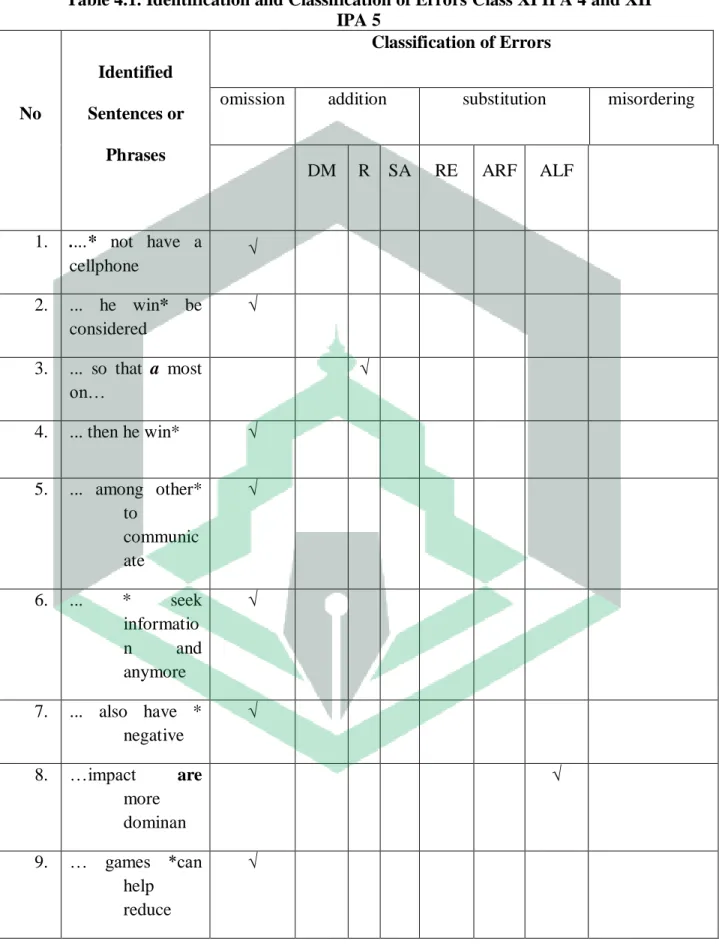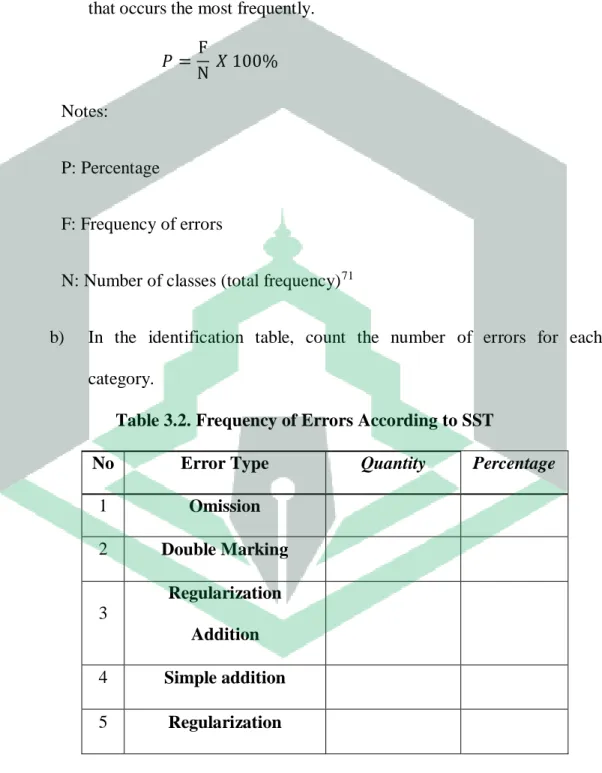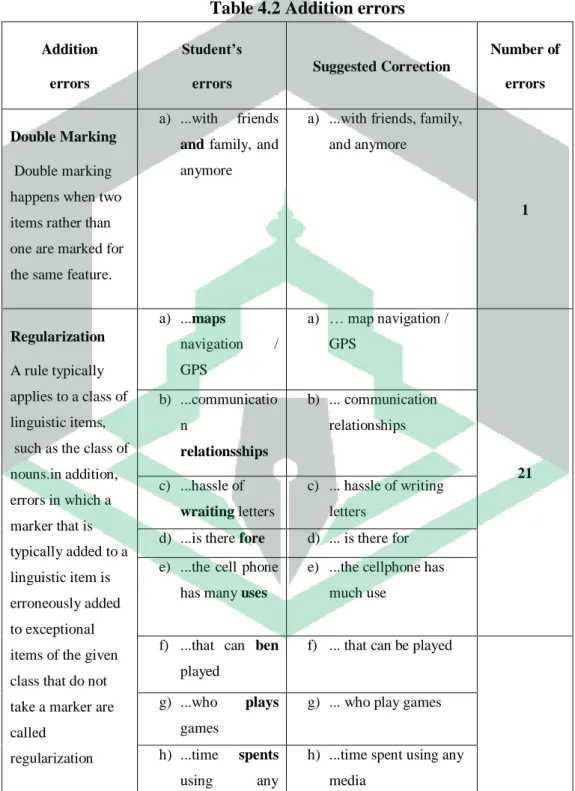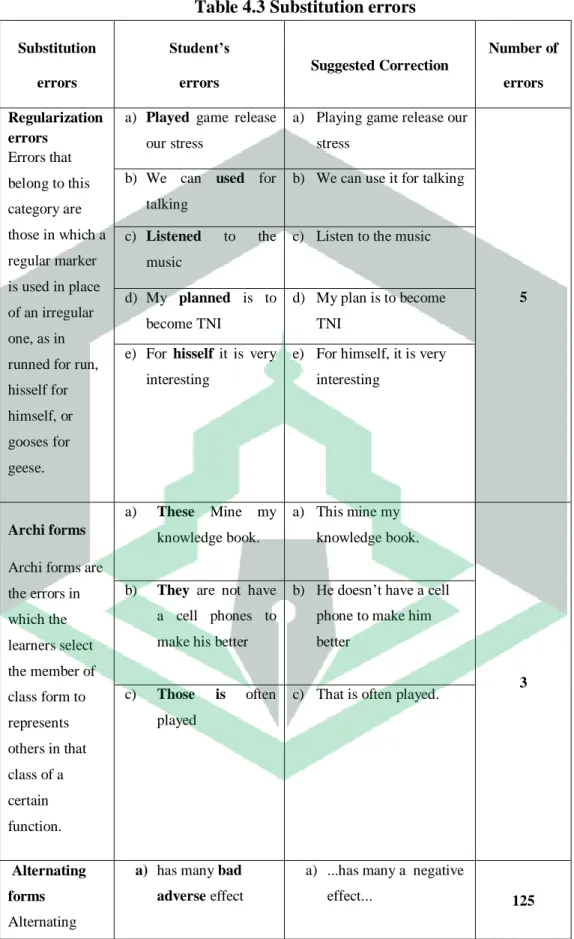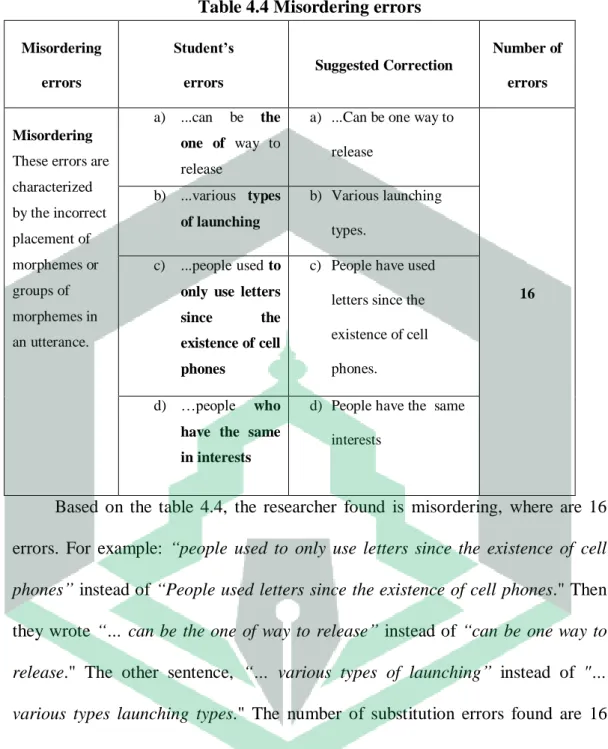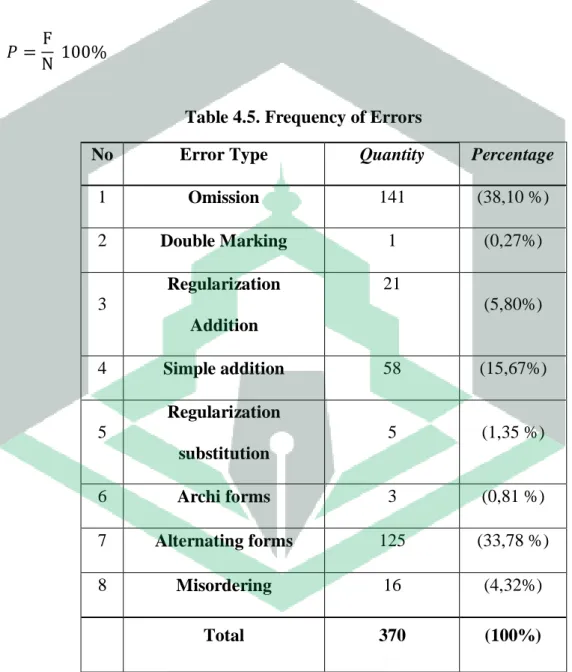Alhamdulillah Rabbil Alamin, praise, and thanks to God Almighty, Allah SWT, without blessing and mercy the researcher would never have been able to begin and complete this dissertation as a requirement for the degree of S.Pd at the State Islamic Institute of Palopo titled An Error Analysis in Writing Analytical Exhibition Text by the Eleventh Grade Students of SMA Negeri 2 Palopo. The researcher realizes that the existence of this thesis receives a lot of advice, guidance, encouragement and comments from many people. Sukirman Nurdjan,S.S.,M.Pd is the Dean of the Faculty of Education and Teacher Education (IAIN) Palopo, who supported the researcher in writing this dissertation.
Specially to all those who gave the researcher spirit, motivation, support and encouragement until this thesis was completed. The researcher hopes that this thesis can provide some value to the students of the English Department, English teachers and readers.
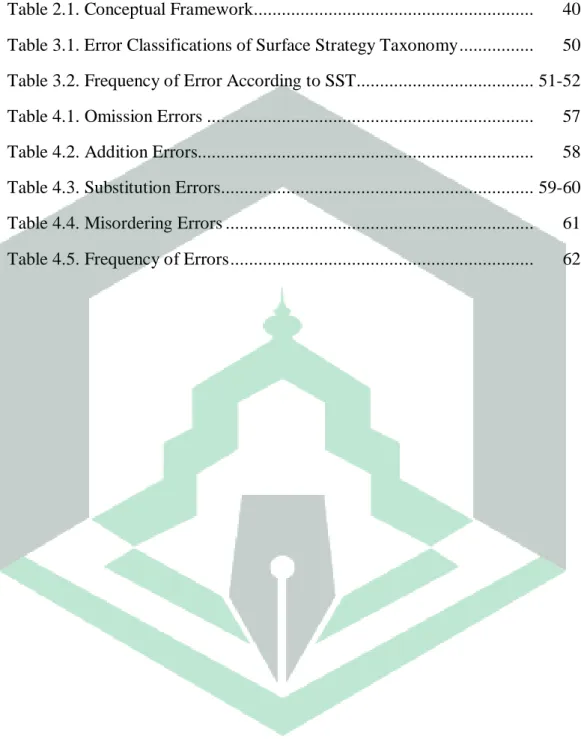
INTRODUCTION
- Background
- Research Question
- Objectives of the Research
- Scope of the Research
- Significance of The Research
Based on the above background, the researcher is interested in analyzing students' errors in writing analytical expository text. What kind of mistakes are found in writing the analytical expository text, do the eleventh grade students of SMA Negeri 2 Palopo. What is the predominant type of error in writing analytical expository text written by eleventh grade students of SMA Negeri 2 Palopo.
To analyze the types of errors in writing analytical expository text made by students of eleventh grade students SMA Negeri 2 Palopo. The scope of this research was about the error analysis in writing an analytical expository text.
LITERATURE REVIEW
Previous Related Study
Below, the researcher examines each of the four different categories of errors. In this study, the researcher focused on writing analytical exposition texts written by the eleventh grade students of SMA Negeri 2 Palopo. The researcher asked the students to write the analytical exposition text based on the topic provided by the researcher.
Based on the explanation above, the researcher analyzed the students' writing test results and found 370 errors in the analytical report. The researcher concluded that the students are unfocused and serious in the writing tests, which showed many errors in writing analytical expository text.
Theory Description
- Concepts or Error Analysis
- Concepts of Writing
- Concepts of Analytical Exposition Text
Conceptual Framework
The conceptual framework describes the steps the researcher intends to take to conduct this research systematically. The previous diagram shows that the first component is for the students to do in their writing the analytical expository text written by eleventh grade students in SMA Negeri 2 Palopo. In the second and third components, the student's writing is collected by the researcher and identified for correcting the student's writing.
By utilizing percentages, performing calculations, and determining the rate in each category, the researcher can determine the type of error that is most common and the type of error that is the worst due to errors that students make when writing analytical expository texts.
RESEARCH METHOD
- Research Type and Approach
- Research Focus
- Definition of Terms
- Research Design
- Data and Data Source
- Research Instrument
- The Procedure of Data Collected
- Data Validity Check
- Technique of Data Analysis
Student writing researchers investigate writing analytical presentation texts and identify grammatical errors based on surface strategy taxonomy. The researcher collected the data from the areas of Class XI IPA 4 and Class XI IPA 4 of Negeri 2 Palopo Primary School. The researcher identified, classified and calculated the percentages of errors in the analytical discussion texts written by eleventh grade students of Negeri 2 Palopo Primary School.
After observing the writing test students, the researcher collected the data and gave a conclusion that class XI IPA 4 and XI IPA 5 almost exclusively made mistakes in their writing, especially in writing analytical expository text. The researcher observed the writing test students, the researcher collected data in class XI IPA 4 and XI IPA 5 almost exclusively made mistakes in their writing, especially in writing analytical expository text.
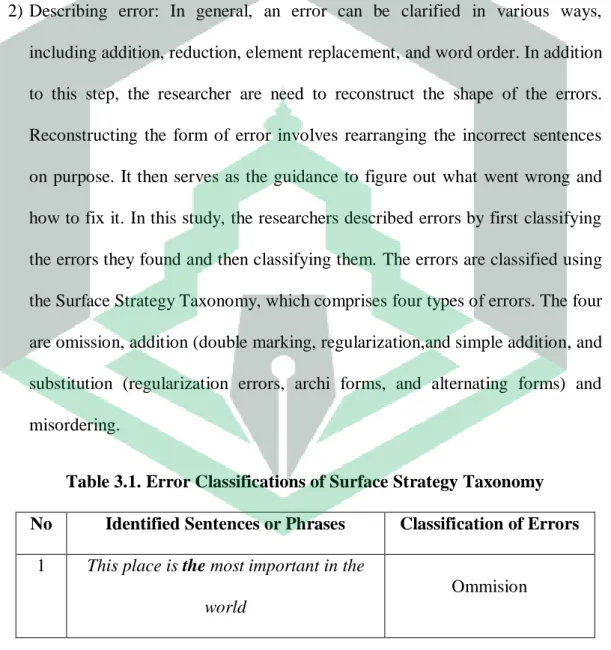
FINDING AND DISCUSSION
Finding
This research aimed to find errors in analytical expository text written by eleventh grade students in SMA Negeri 2 Palopo. The students' analytical expository text included the first meeting in class XI IPA 4 and the second meeting in class XI IPA 5, including 370 errors in sentences or sentences. Dulay and colleagues therefore classify the error as one of four different varieties, primarily based on the taxonomy of surface techniques, which includes four types of errors.
On the other hand, as in the sentence "..it can teach children some essential values" instead of "..it can teach children important values". These mistakes indicated that they had not yet mastered writing in an analytical discussion text, as they did not understand the basics. 0.00% After the written test, the researcher conducted two interviews with different students in the class.
Based on the findings of interviews conducted by researchers with the respondent for question 1, some students struggle to write the writing test in English, especially to translate the word, to know the meaning and some do not have vocabulary. At the same time, some students feel that writing test is easy to work on because the technology helps them understand the type of text. Why it is not difficult to cause, there are topics, and we have chosen only one of them.
I don't find it difficult to write text because the answer is linear from my brain and easy for me to do the writing test. Based on the results of interviews conducted by researchers with the respondent for question 2, some students find it difficult to write the analytical expository text in English, especially in structuring the text, translating the word and arguing, but some students find it easy to learn the writing. test because they answer from their own selves and the subject is ready to work. Based on the result of interviews conducted by researchers with the respondent for questions 1 and 2, there is the problem of the students.
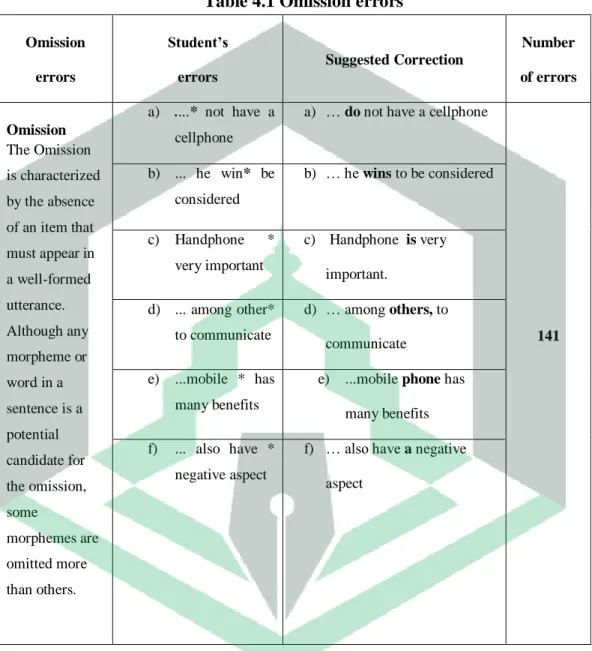
Discussion
The researcher concluded that they should pay more attention when English teachers carefully explain analytical exposition text materials and basic English. As a result of this research, the researcher analyzed the student's error based on surface strategy taxonomy in writing analytical exposition text as research focus and showed success. Insist that students have studied the analytical expository material before taking the writing test.
The data analysis of the previous chapter illustrates some conclusions on the errors in writing analytical expository texts written by eleventh grade students of SMA Negeri 2 Palopo, especially grade XI IPA 4 and grade XI IPA 5. This problem was found by the researcher based on the result of the analyzed errors, and the errors can be classified into four types of errors based on the surface strategy taxonomy, there are four types of errors that occurred in the students' analytical exposure text: 1) omission. Design some fun activities to help them develop their skills to reduce student errors in writing analytical expository text.
Second, other factors that may have contributed to an error in writing an analytical statement should be examined. Marlina, 'Students' Ability in Writing an Analytical Exposition Text at English Department of Universitas Negeri Padang, Journal of English Language Teaching, 7.1 2018. Permatasari, Aprilista Dwi, Testiana Deni Wijayatiningsih and Dodi Mulyadi, 'Error Analysis on EFL Learners' Analytical Exposition writing,” Surakarta English and Literature Journal, 1.1, 2018.
Putri, Rahmi Eka dan Amri Isyam, 'Pengajaran Membaca Teks Analytical Exposition melalui Teknik Herringbone kepada Siswa SMA, Jurnal Pengajaran Bahasa Inggris, 2.1, 2013. Testi, R, F Harmaini dan Y Yandri, 'Mengajar Menulis Analytical Exposition Teks Dengan Menggunakan Mind Mapping', Jurnal Fakultas Keguruan dan Ilmu Pendidikan 3 6, 2014. Peneliti : Lalu yang kami kerjakan adalah apakah ada kesulitan dalam menulis khususnya teks ekspositori analitis.
CONCLUSIONS AND SUGGESTIONS
Conclusions
Suggestions
First, students should improve their understanding of English grammar, especially in articles published in English, to eliminate errors in their written work. Third, students need to become more aware of the importance of English grammar so that they are motivated to master it. Amir, Faisal, 'An analysis of grammatical errors in writing made by English education students at IAIN Palopo', 2020.
Arjati, Artin Feriana, "An Error Analysis on the Use of Gerund among the Fourth Semester Students of the English Department of Unnes in the Academic Year of. Caroline Mei Lin Ho, 'Empowering English teachers to grapple with errors in grammar mlcho at nie.edu.sg Nanyang Technological University Singapore TESL Journal 9 3, 2003. Hakim, Lukman, 'Error Analysis on Students' Translation at The Fifth Semester Students of English department IAIN Palopo', Skripsi Sarjana Pendidikan, Palopo : Perpustakaan IAIN Palopo, 2015.
Hornby, 'Oxford Advanced Learner's Dictionary, Ed.; šesti, Great Clarendon Street, Oxford OX2 6DP, Oxford University Press. Israil, Irnawati, 'An Error Analysis on Students' Writing at the Fourth Semester Students of English Study Programme of Tarbiyah Departement at STAIN Palopo,' Unpublished Thesis, Palopo: STAIN Palopo, 2013. Arasuli, 'An Error Analysis on English Gerunds Made By Študentje šestega semestra študijskega programa Angleščina Unib v študijskem letu Journal of English Education and Teaching, 2.4., 2019.
Yully Widyawati, Wiwik, 'Analisis Kesalahan Penggunaan Gerund yang Dibuat oleh Mahasiswa Semester IV Jurusan Bahasa Inggris UNINDRA,' Jurnal Tell-Us, 4.2 2018. Sunardi Hasyim, "Analisis Kesalahan dalam Pengajaran Bahasa Inggris2" Bagian 4, nomor 1 Juni 2000, http://puslit.petra.ac.id/journals/letters/. Peneliti : Oh begitu, yang penting ada tahapannya dan hampir sama dengan teks bahasa Indonesia dan bahasa Inggris.
Iftita : Kamu gak terlalu jahat, aku ngomong bahasa inggris gan, apalagi aku susah ngomongnya, makanya aku jadi tutor. Peneliti: Nah, Nur Arini, menurut Anda menulis teks dalam bahasa Inggris itu mudah atau sulit? Peneliti : Menurut tadi, ketika kami sedang menulis teks ini, ada masalah dalam penulisannya.
Ria: Masalah penerjemahan dari bahasa Indonesia ke bahasa Inggris menurutku cukup sulit ya kak.
